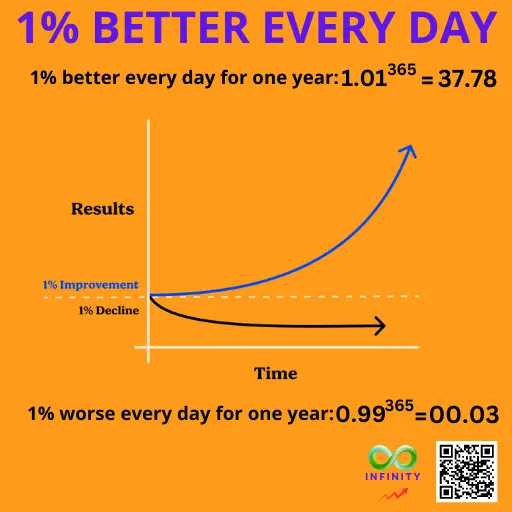
Introduction
In this Atomic Habits review, we explore how James Clear’s book provides practical insights into building good habits and breaking bad ones. In his book Atomic Habits: An Easy & Proven Way to Build Good Habits & Break Bad Ones, author James Clear presents a compelling case for transforming one’s life through the science of habit formation. This Atomic Habits book review explores how Clear emphasizes that small, incremental changes—what he calls “atomic habits”—can lead to profound personal and professional growth over time.
By focusing on habit-building techniques and habit-formation strategies, Clear provides a step-by-step guide that teaches readers how to build good habits and break bad habits effectively, demonstrating that small habits lead to big changes.
James Clear’s Atomic Habits is aimed at a diverse audience, from those exploring self-improvement habits to professionals seeking increased productivity or students looking for better study routines. As one of the bestselling self-help books in recent years, it appeals broadly to anyone looking to make lasting improvements. The book’s research-backed, practical advice showcases tiny habits examples that lead to transformative change, making it a standout among personal growth books. Clear’s approach ensures that readers are equipped with actionable steps to integrate positive habits into their daily routine, cementing its place among the best habit books and top self-help books available.

Click here to start mastering the art of creative visualization and transform your reality! These links help support our work through commissions.
Building Good Habits – A Core Message from Atomic Habits
Atomic Habits provides a comprehensive framework for habit transformation, focusing on practical, science-backed strategies to help readers build good habits and eliminate bad ones. In this Atomic Habits summary, Clear outlines the habit formation science behind successful behavior change through his four fundamental principles, or four laws of behavior change, which ensure that habit change is both effective and sustainable. These laws reflect the core idea that by making small daily improvements, one can achieve significant results over time—a concept Clear illustrates through the compound effect of habits, where consistent 1% improvements each day lead to exponential growth by the end of the year. Each chapter introduces and elaborates on the four laws.
The first law, “Make it Obvious,” highlights the importance of recognizing contextual cues in our environment and emphasizes the need for intentional habit cues as part of James Clear’s habit-building process.
The second law, “Make it Attractive,” focuses on the psychology behind habits, explaining how habits are formed in the brain and how we can rewire our neural pathways to make good habits more appealing and use positive associations to reduce the allure of bad habits.
The third law, “Make it Easy,” teaches readers how to create new habits by removing friction and making the desired behavior as effortless as possible. This section also introduces the habit stacking strategy, a technique where new habits are anchored to existing ones, making them easier to integrate.

FIGURE 1: The effects of small habits compound over time. For example, if you can get just 1 percent better each day, you’ll end up with results that are nearly 37 times better after one year.
The fourth law, “Make it Satisfying,” explains how to break bad habits by emphasizing the importance of immediate rewards and positive reinforcement to ensure habits stick.
A particularly notable section is Clear’s discussion of the “Goldilocks Rule,” which emphasizes the importance of balancing challenge and ease to stay motivated and engaged. Clear also weaves his personal experience of recovery into the book, showing how small steps and micro habits over time can lead to transformative changes. This focus on habit consistency and the habit loop of cue-routine-reward makes Atomic Habits one of the best books on habits and a must-read among books about changing habits.

FIGURE 2: We often expect progress to be linear. At the very least, we hope it will come quickly. In reality, the results of our efforts are often delayed. It is not until months or years later that we realize the true value of the previous work we have done. This can result in a “valley of disappointment” where people feel discouraged after putting in weeks or months of hard work without experiencing any results. However, this work was not wasted. It was simply being stored. It is not until much later that the full value of previous efforts is revealed.
Atomic Habits Review: Key Takeaways
Atomic Habits excels in many ways, particularly in its clear and practical presentation of complex ideas, making it a standout in the genre of self-development books. One of the key Atomic Habits strengths and weaknesses lies in its focus on small, incremental changes rather than advocating for drastic transformations. This emphasis on sustainability is refreshing compared to other self-help books that promise quick fixes. Clear’s approach, rooted in thorough habit formation research and psychological research, offers a solid foundation for readers to understand and reshape their habits, drawing on concepts like neuroplasticity and the habit loop.
One of the book’s strengths is James Clear’s writing style. It is both accessible and engaging, striking a balance between storytelling and educational content. Clear employs real-world examples of habit-building to illustrate complex concepts, making them easy for readers to grasp. His analogy of habits as a “double-edged sword” emphasizes how automatic behaviors can either work for or against us. This practical advice is particularly valuable for readers looking to improve their habits and productivity, cementing Atomic Habits‘ place among the best books on habits.
In terms of behavior change methods, Clear’s use of evidence from psychology, neuroscience, and marketing adds credibility. His psychological habits analysis deepens the reader’s understanding of the science behind habits, offering insights into why past efforts to change may have failed. The focus on habit-building vs goal-setting is another significant contribution. Clear argues that focusing on the process rather than the end result is more effective, a perspective that resonates with readers seeking long-term behavior change and self-discipline.
However, there are some areas where the book could be stronger. One of the notable weaknesses is the occasional repetition of ideas, which can feel redundant even though it serves to reinforce key concepts. Additionally, while the book covers a robust habit formation framework and habit strategies, it does not delve deeply into the emotional and psychological struggles that come with breaking ingrained habits. Addressing these challenges would have enhanced the overall impact of the book.
Despite these minor shortcomings, Atomic Habits remains highly relevant in today’s world, where people constantly seek ways to improve productivity, manage stress, and achieve personal goals. Clear’s practical advice is timely, offering readers tools to navigate the distractions of modern life. Whether it’s improving health, focusing on career goals, or managing digital overload, the book’s principles are applicable across various aspects of life, making it a valuable resource for personal growth and productivity. Its emphasis on keystone habits, identity-based habits, and a mindset shift solidifies its position among the top personal development books and habit forming books.
Personal Reflection
My personal experience with Atomic Habits has been profoundly transformative. Before reading the book, I held the belief that meaningful change required large, daunting efforts. However, how Atomic Habits changed my life lies in James Clear’s philosophy that small, consistent steps lead to significant long-term results. The impact of small habits felt liberating and intuitive, as it shifted my focus from overwhelming goals to manageable simple actions.
This practical approach made it easier to incorporate habit systems for personal growth in areas where I previously struggled, such as maintaining a fitness routine or improving time management through habit tracking and goal setting. Applying Atomic Habits in daily life was remarkably straightforward, thanks to Clear’s emphasis on consistency in habits. By following his strategies, I found myself making incremental yet sustainable improvements in my personal and professional life. The book’s structure encouraged me to build momentum through small wins, reinforcing Clear’s idea that progress is more about the systems we use than the goals we set. This approach helped me develop greater self-efficacy and autonomy in my habit formation journey.

Reading the Atomic Habits success stories reinforced my belief that real-life transformations are possible when these principles are consistently applied. In terms of habit changes in real life, I’ve seen marked improvements in productivity, focus, and overall well-being. Compared to other self-help books, such as The Power of Habit by Charles Duhigg, Clear’s practical insights felt more actionable and accessible, especially for those who struggle with habit motivation or maintaining long-term habits.
For anyone seeking personal growth or lasting behavior change, Atomic Habits provides a clear, evidence-based roadmap that can easily be integrated into everyday life. Its focus on habit rewards, habit triggers, and the habit science behind behavior change makes it an invaluable resource for those looking to improve their lives through consistent, small actions. As one of the must-read self-help books and best books for self-improvement, Atomic Habits is a game-changer for anyone seeking to unlock their full potential.
Conclusion
In conclusion, is Atomic Habits worth reading? Absolutely. Atomic Habits by James Clear is a comprehensive and practical guide to habit formation that stands out among the best productivity books and self-help books. In my final thoughts, the book’s unique approach to small, consistent changes makes it an invaluable resource for those seeking long-term improvement. Who should read Atomic Habits? Anyone interested in self-improvement, whether they are students, professionals, or individuals looking to optimize their daily routines.
For readers exploring personal development book reviews or seeking recommendations for habit-building books, Atomic Habits should be at the top of the list. Clear’s emphasis on actionable advice and his deep understanding of behavioral psychology provide a strong foundation for reading Atomic Habits for self-improvement.
His strategies for creating sustainable habits can be applied across various aspects of life, from fitness and health to productivity and personal goals. For more insights on effective Goal Setting, check out this post. In terms of an Atomic Habits book rating, I would confidently place it among the most impactful self-help books of recent years. If you’re looking for practical tools to create lasting change, James Clear’s habit advice is both accessible and transformative, making this book a must-read in the realm of personal growth. As one of the top self-help books, best personal growth books, and books on changing habits, Atomic Habits is an essential addition to any self-development library.
Call to Action
If this book sounds like something you’d love, consider purchasing it through the link below. Not only will you gain valuable insights from Atomic Habits by James Clear, but your purchase also supports our blog in continuing to provide honest, in-depth reviews like this one.
Thank you for your support!
By Jambo T.
Share this post: on Twitter on Facebook


